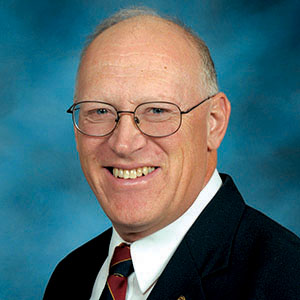Kansas Profile – Now That’s Rural: Don Atha, bug sculptures
At a glance: Don Atha and his wife Rebecca believe strongly in the value of public art. After moving to Anthony, Don had the idea to create large metal sculptures of bugs to place around the community. Now there are 30 bug sculptures on display -- with more in production.
More information: Ron Wilson, rwilson@ksu.edu, 785-532-7690
Photos: Ron Wilson | Don Atha
Website: Huck Boyd National Institute for Rural Development
Aug. 28, 2024

By Ron Wilson, director of the Huck Boyd National Institute for Rural Development at Kansas State University
There’s a caterpillar in the garden, and it’s 18 feet long. But don’t worry: This is not an alien invasion and your tomatoes are not at risk.
The garden is a sculpture garden. It is part of an effort to use folk art – in this case, bug sculptures - to attract visitors to a rural Kansas community.
 Don Atha is the Kansan who spearheads this effort to use public folk art to benefit the community. Atha grew up in Mission Hills where his family was active in supporting the arts.
Don Atha is the Kansan who spearheads this effort to use public folk art to benefit the community. Atha grew up in Mission Hills where his family was active in supporting the arts.
Right: Sheila Adams, President, Anthony Chamber of Commerce; Kari O’Riley, Harper County Community/ Economic Development; Don Atha; Howard Hatfield, City Commissioner | Download this photo
“Thanks to my family, I feel like I was raised at the Nelson-Atkins Museum of Art in Kansas City,” Atha said. His family donated several pieces to the museum.
“Art is important to the development of a community,” Atha said.
After college back east, he worked in the banking and health care finance industries around the country. He moved to Arizona and started his own commercial printing brokerage business called West Print.
Art galleries were among his clients, along with the second largest time share company in the world. He also collected art. He even met his wife Rebecca at an art show. They ultimately moved to Belize.
When Covid hit, they decided to move to back to Atha’s home state of Kansas. A realtor found them a home in Anthony, about 45 minutes from Wichita. “Kansans are good people,” Atha said.
In Anthony, Atha joined a civic club that was brainstorming about how to bring more people to the community. “I thought of communities that have benefitted from introducing art,” Atha said. Numerous places have featured different versions of a particular symbol throughout their city.
“I thought bugs might be a hook,” Atha said. He set out to build bug sculptures that could be displayed around Anthony. These are metal sculptures from recycled metal pieces that are welded together and painted.
Atha and friends worked near his home in a building called Where Bugs Come Alive Studio. He also created a nearby sculpture garden. That became home to the first bug sculpture. It was called Cat-apillar and was followed by a Daddy Long Legs spider.
The secretary of the local Kansas Community Empowerment group successfully applied for a grant that provided additional funds for supplies. The grant was to provide for five bug sculptures in the first year. They were done in six months.
Today, there are 30 bug sculptures in the community of Anthony with more in production. These are displayed around town where possible
“It’s an infestation, but not of bad bugs – of fun bugs,” Atha said. They’ve become popular sites for selfies.
These now include Ladybug, Anthony Ant, Bumble Bug, Roadrunner Bug (in honor of the local school mascot), Jolly Green Bug, Cosmic Cyclops Bug, a patriotic eight-foot-tall Uncle Sam Bug, and more. “Some are built from old 48-inch wagon wheels, which connects us to our history,” Atha said.
“This is an off-the-wall idea of attracting people with folk art.”
All of the bugs are donated, mostly by Atha and his wife. No tax dollars have been used to support the project. A team of volunteers helps the Athas.
Atha said he enjoys the pleasure that these quirky designs bring visitors and hopes they will attract more people. “This is for fun, it’s to bring a smile to your face,” Atha said. “I’d like to have bus tours. Come enjoy the bugs.”
It’s a creative idea for a rural community such as Anthony, population 2,108 people. Now, that’s rural.
“Anthony has a really nice museum, a cotton gin, Official Kansas 9/11 Memorial, and a historic theater and courthouse,” Atha said. “We have really attractive housing stock.”
“I believe in the arts and how they can benefit a community,” Atha said.
For more information, contact Atha at donathawestprint@gmail.com or visit Where Bugs Come Alive Studio on Facebook.
There’s an eighteen-foot long caterpillar in the garden. Fortunately, it’s a sculpture of a caterpillar in a downtown sculpture garden. We salute Don and Rebecca Atha for making a difference with this creative initiative.
Don’t let it bug you.
Audio and text files of Kansas Profiles are available at www.huckboydinstitute.org/kansas-profiles. For more information about the Huck Boyd Institute, interested persons can visit www.huckboydinstitute.org.
***

K‑State Research and Extension is a short name for the Kansas State University Agricultural Experiment Station and Cooperative Extension Service, a program designed to generate and distribute useful knowledge for the well‑being of Kansans. Supported by county, state, federal and private funds, the program has county extension offices, experiment fields, area extension offices and regional research centers statewide. Its headquarters is on the K‑State campus in Manhattan. For more information, visit www.ksre.ksu.edu. K-State Research and Extension is an equal opportunity provider and employer.